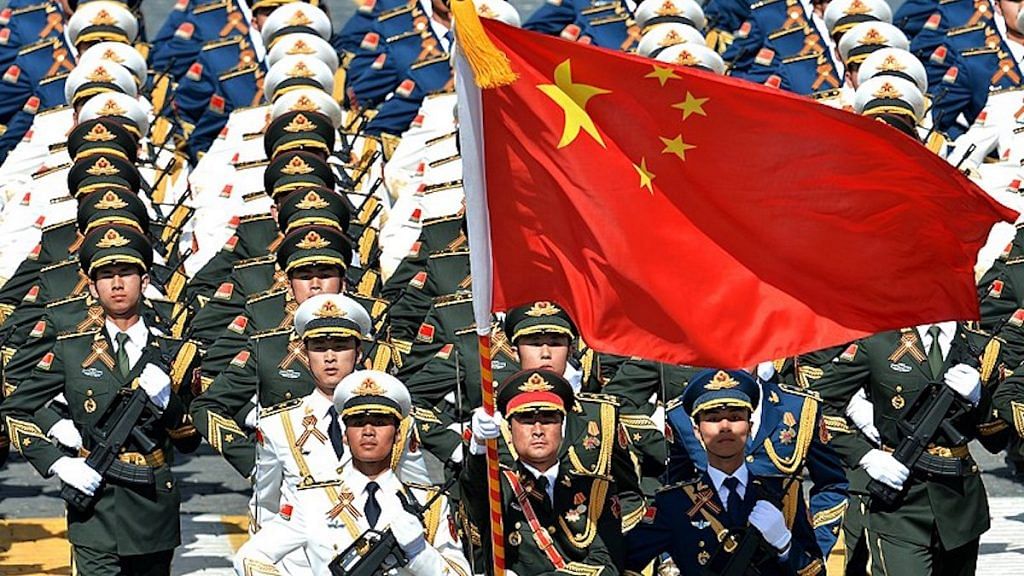New Delhi: Last week, China passed a new law — the Land Border Law — that will come into force from 1 January onwards and is expected to pose a massive challenge for India, which has a 3,488-km unsettled border with the country.
The law, passed by Beijing Saturday, deals with the country’s patrolling activities on its 22,100-km land border with its 14 neighbouring countries, and is considered to be the first such policy move in China’s modern history.
According to the new law, “the state shall take effective measures to strengthen border defence construction, support the economic and social development of the border and open up to the outside world, promote the action of strengthening the border and enriching the people of the border, improve the level of border public services and infrastructure construction, improve the production and living conditions of the border, and encourage and support border residents in border production and life, and promote the coordinated development of border defence construction and border economy and society”.
The law was passed, according to Beijing, to “safeguard national sovereignty, security and territorial integrity” while promoting “good neighbourly friendship and exchanges and cooperation” with the countries it shares land borders with.
The law has stoked some curiosity as it comes amid India’s year-long border dispute with China in Ladakh, which continues despite disengagement at a few of the stand-off sites. While some experts say the law suggests a toughening of China’s negotiating stance, others believe it is “hot air”.
Gautam Bambawale, former Indian Ambassador to Beijing and Thimpu, told ThePrint that the law “is a lot of verbiage. It is a lot of hot air. It doesn’t change the realities on the ground”.
“By its military actions commencing May 2020, China has shown that it wants to settle the boundary with India, not through negotiations but by use of force. India has given them a befitting response. The India-China relationship has deteriorated over the past months since May 2020. If this new law was a message to India, I am afraid it has fallen flat on its face as it does not change the situation on the ground at all,” he added.
Last June, Indian and Chinese soldiers clashed at the Galwan valley in eastern Ladakh. India lost 20 soldiers, while the number of Chinese fatalities is not yet clear.
In September 2020, during a meeting between External Affairs Minister S. Jaishankar and his Chinese counterpart Wang Yi, both sides agreed to revisit the five existing border agreements and review confidence-building measures.
Also read: China believes its time has come. But here’s what it hasn’t come to terms with yet
‘New law extremely important from Indian perspective’
Explaining the specific provisions of the new law, Manoj Kewalramani, Fellow-China Studies at The Takshashila Institution, said, “The new law is extremely important from an Indian perspective. India is one among two countries that share a disputed land boundary with the People’s Republic, and the legislation will impinge on this.”
Kewalramani, who is also author of Smokeless War: China’s Quest for Geopolitical Dominance, said Article 1 of the policy that talks about “delineation and demarcation of land borders” and Article 4, which stipulates that “sovereignty and territorial integrity” are “sacred and inviolable”, are indicative of a “tougher stance” that China will take on boundary negotiations when it comes to India.
“This is a broad legislation that deals with not just border security and development, but also management, and authorises key agencies for specific tasks. This is partly an effort to put in place legal structures, identify tasks and responsibilities and establish frameworks authorising government action,” he said.
He added that another aspect of the law — Article 10 — calls for coordinated development of border security and economy.
“This entails strengthening border defence, supporting the economic and social development along border regions and improving public services and infrastructure in the areas. This provides a stronger legal framework and impetus for work related to border villages that have been built across Tibet,” he said.
Antara Ghosal Singh, China scholar and researcher, who was formerly with the Centre for Social and Economic Progress (CSEP), said the land boundary law has been under discussion for some time in China. The key drivers, Singh added, have been its interest to bring uniformity and standardisation and prevent contradiction in China’s border management policies and regulations at the central and provincial levels.
“It is part of China’s western development strategy, which has been there since the ’90s. More precisely on Tibet, they want to construct what they call a ‘South Asian Grand Passage’,” said Singh.
Also read: Neither MoD nor MHA can resolve the unacceptable state of affairs on Indo-Tibetan Border
Disengagement discussions
Both India and China have had a series of discussions at the military as well as diplomatic level for disengagement based on the five existing protocols that have been put in place over border management since 1993.
The pacts are the 1993 Agreement on Maintenance of Peace and Tranquility along the Line of Actual Control in the India-China Border Areas; the 1996 Agreement on Confidence Building Measures in the Military Field along the LAC; the 2005 Protocol on Modalities for the Implementation of the Confidence-Building Measures in the Military Field along the LAC; the 2012 Agreement on the Establishment of a Working Mechanism for Consultation and Coordination on India-China Border Affairs; and the 2013 Border Defence Cooperation Agreement.
According to a former R&AW officer, who did not wish to be named, the law only ensures that the Chinese negotiating stance will become “tougher and more rigid” and does not alter its tensions with India.
Earlier this month, China and Bhutan signed a memorandum of understanding to speed-up their border negotiations.
(Edited by Poulomi Banerjee)
Also read: India, China should properly handle differences, move towards stability, envoy Sun Weidong says
